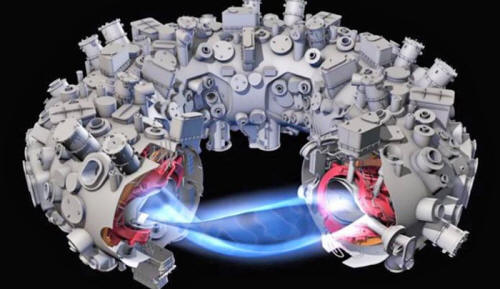|
Nuclear fusion happens when atoms fuse together at extremely high temperatures to generate energy, and this reaction has the potential to produce an almost unlimited supply of energy from very little.
This is the process that has fuelled our sun for billions of years, and is unfortunately very difficult for scientists to achieve. We keep trying, however, because it doesn't produce any radioactive waste, unlike modern day nuclear power plants (which are powered by nuclear fission rather than fusion.)
In a remarkable breakthrough, however, scientists in Germany have recently announced that one of the world's largest nuclear fusion machines has been successful for the first time.
Hans-Stephan Bosch and his team at the Max Planck Institute were able to produce a "loose cloud" consisting of charged particles known as "helium place." They did this through a stellarator called the 7-x, which is a device used to confine hot plasma with magnetic fields in order to produce a nuclear fusion reaction.
The 7-x is considered to be the largest and most well-bred stellarator on the planet. (source) (source) (source)
Basically, the key to nuclear fusion is to control a portion of extremely hot/heated matter (plasma); if done successfully, electrons are separated from their atoms, resulting in the formation of ions. Ions usually bounce off each other, but the process of nuclear fusion places them under conditions which result in them fusing together, which in turn generates energy.
This energy output is known as nuclear fusion.
Being able to harness this type of energy would change the world. Nuclear fusion represents a near perpetual source of energy that would wipe out our currently outdated and wasteful methods of producing energy.
It is important to mention that the reaction only lasted for one-tenth of a second, but Hans-Stephan Bosch has said that he and his team are "very satisfied" with the results and "everything went according to plan."
Again, this is the first helium plasma that was produced from the 7-X device, and the objective of this research is to develop a power plant favorable to the climate and environment which derives its energy from the fusion of atomic nuclei, just as the sun and stars do.
Another promising development in the field of new energy is the over-unity reactionless generator that was recently invented in India by Paramahamsa Tewari, an electrical engineer and former Executive Director of Nuclear Power Corporation of India.
You can read more about that story here.
It's definitely past due for the world to start a new energy revolution; significant breakthroughs have been coming about for decades, but they never see the light of day.
The world's largest private bank, UBS, is urging investors to join the clean, renewable energy movement.
Analysts at the bank say that power plants in Europe might be extinct within the next 10 to 20 years.
Cold Fusion?
Cold fusion is a certain type of nuclear reaction that occurs at or near room temperature.
In years past, it was studied as theoretical and hypothetical, but scientists all over the world have attested to the possibility of cold fusion becoming a reality and the tremendous implications it can have for clean energy generation.
It is a form of energy generated when hydrogen interacts with various metals, like nickel and palladium. It has been subject to a large amount of criticism and opposition, and while many remain skeptical, a number of distinguished scientists have confirmed its reality.
Cold fusion would also eliminate the modern day energy industry, and this is not just a crazy theory; hundreds of people in over 12 countries have been investigating the process with success.
Thousands of papers have been published and are available for review at Low Energy Nuclear Reactions - Chemically Assisted Nuclear Reactions (Cold Fusion).
A paper published by Martin Fleischmann and Stanley Pons, for example, claimed to successfully demonstrate cold fusion (see Electrochemically Induced Nuclear Fusion of Deuterium).
It is highly controversial, and you can learn more about it by listening to this lecture given by MIT professor Peter Hagelstein. He outlines that the primary implication of the Fleischmann-Pons experiment is that there may be new physics which allow for clean nuclear energy production.
A few years ago, a group of scientists led by physics professor Yoshiaki Arata of Osaka University in Japan claimed to have made a successful demonstration of cold fusion.
Below is a video of Eugene Mallove, who held a BS and MS degree in aeronautical and astronautical engineering from MIT and a doctorate in environmental health sciences from Harvard University.
He was also the chief science writer at the MIT news office at the time of the (supposed) first cold fusion breakthrough in 1989.
It's also important to mention that new documents obtained via the Freedom of Information Act (FOIA) have revealed how the Patent Office has been using a secret system to withhold the approval of some applications.
This 50-page document was obtained by Kilpatrick Towsend & Stockton, LLP, who commonly represent major tech companies that include Apple, Google, and Twitter (to name a few).
You can view that entire document HERE.
It's also important to note (as reported by the Federation of American Scientists) that there were over 5,000 inventions that were under secrecy orders at the end of Fiscal Year 2014, which marked the highest number of secrecy orders in effect since 1994. (source)
As Steven Aftergood from the Federation of American Scientists reports:
It's something to think about.
|


